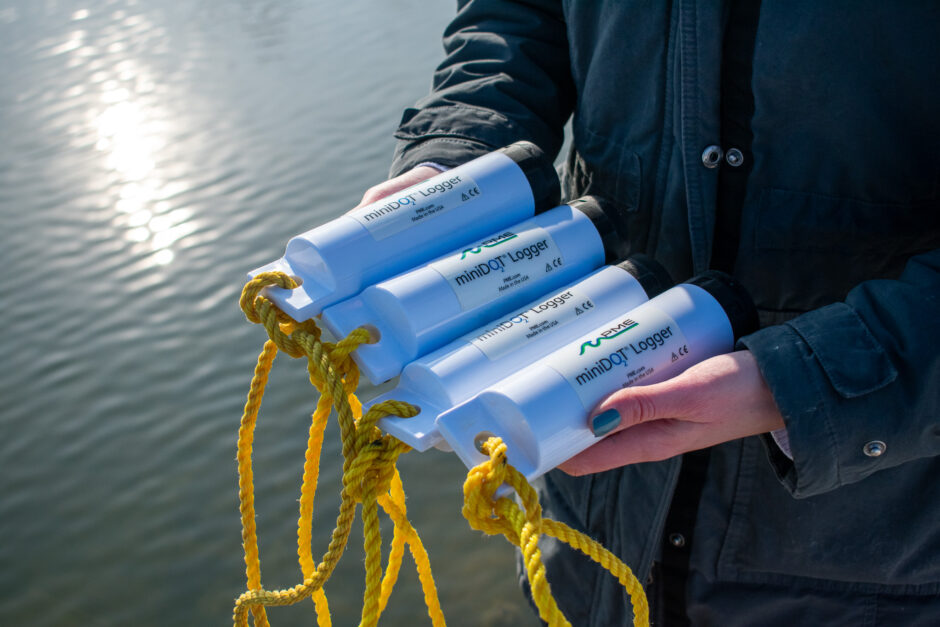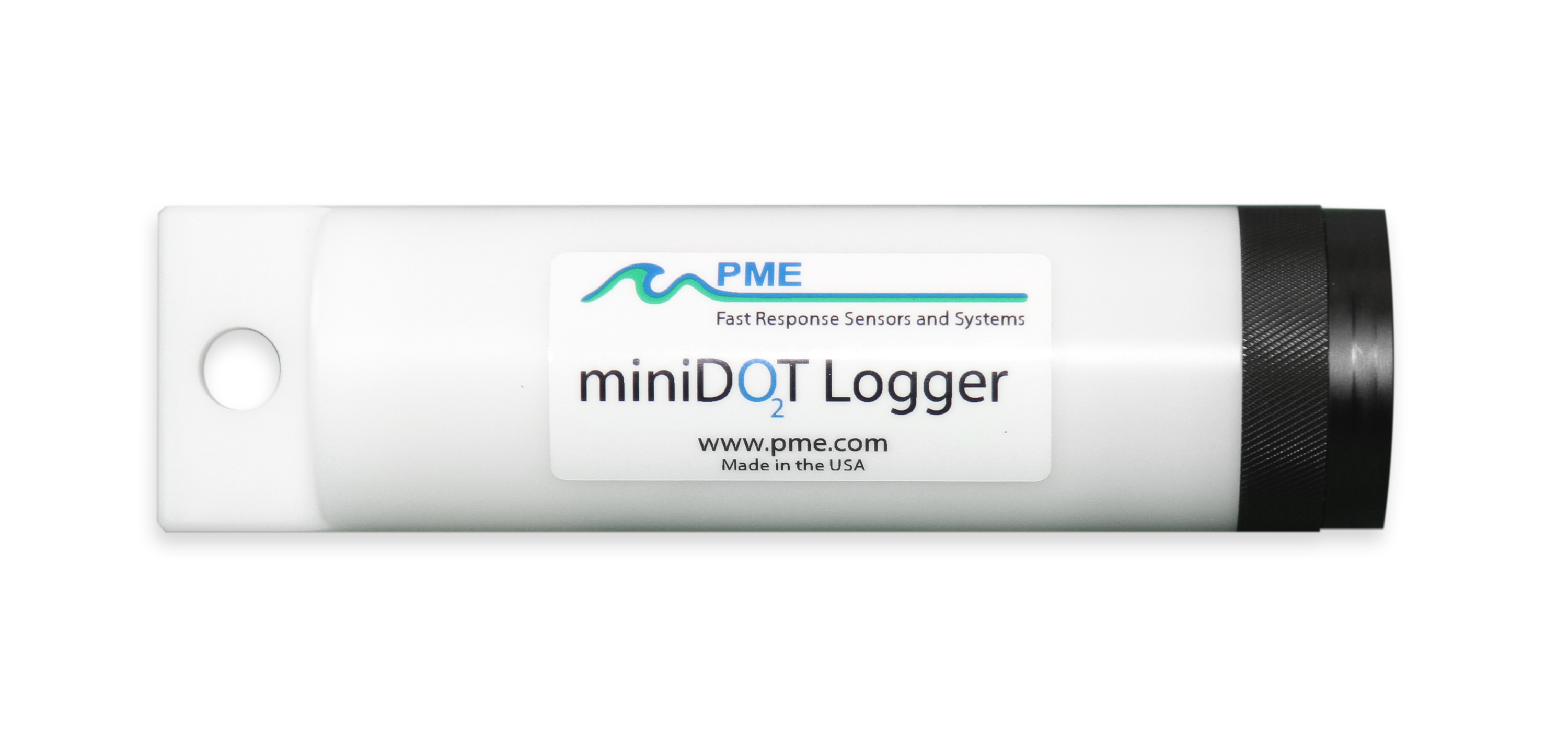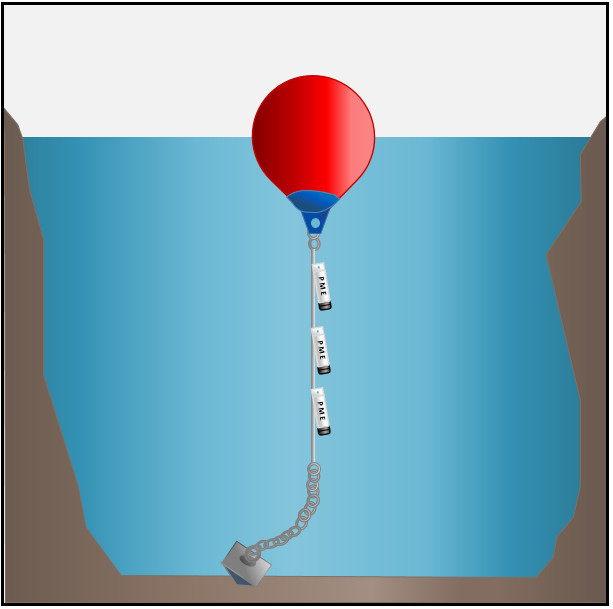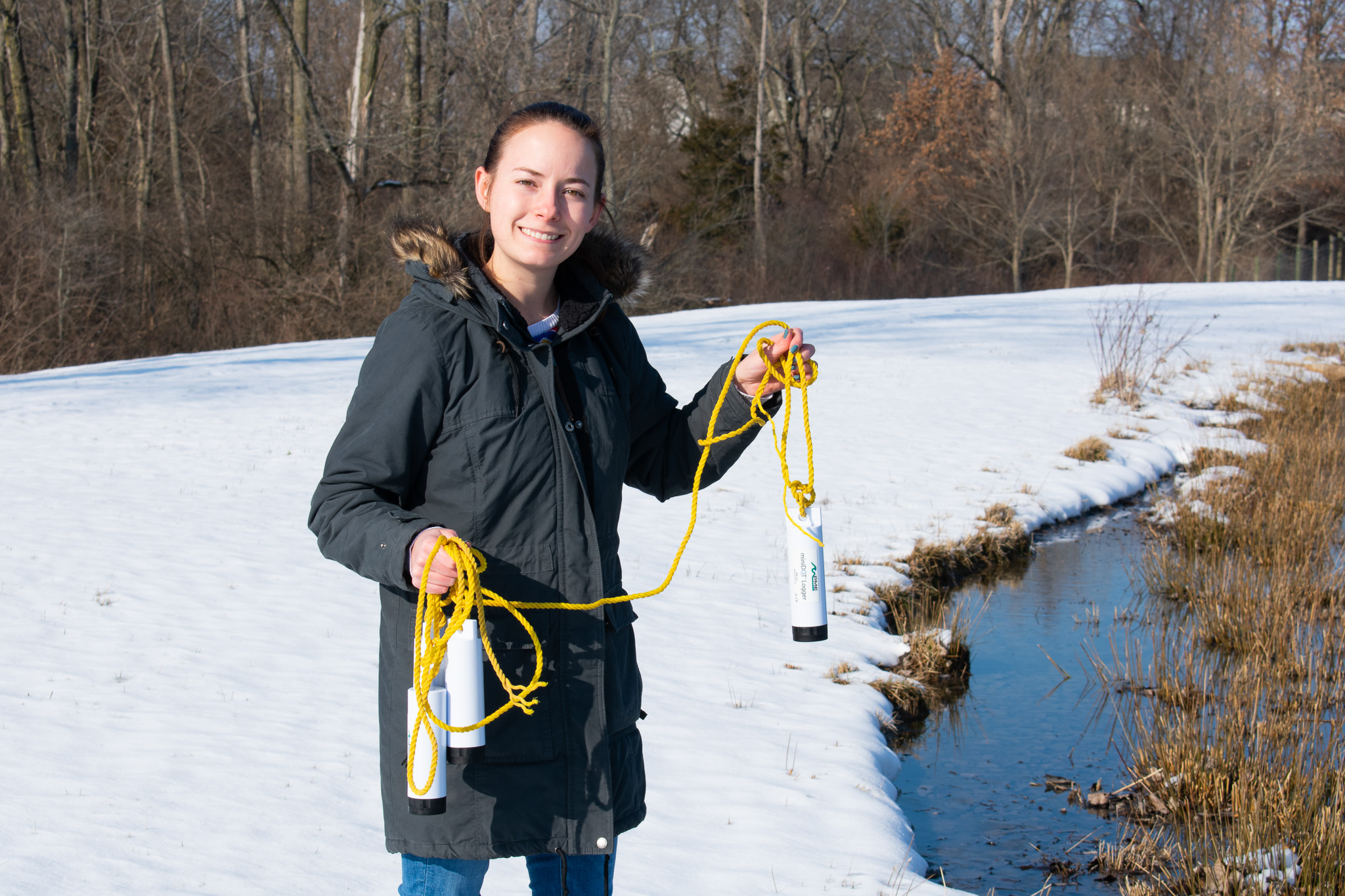PME miniDOT Logger: Plunge into Data
 Four PME miniDOT Loggers about to be deployed at the Fondriest Center for Environmental Studies. (Credit: Emma Jones / Fondriest Environmental, Inc.)
Four PME miniDOT Loggers about to be deployed at the Fondriest Center for Environmental Studies. (Credit: Emma Jones / Fondriest Environmental, Inc.)The PME miniDOT Logger is a compact data logger that measures dissolved oxygen (DO) and temperature down to 100 meters in depth. The unit can also endure low water temperatures and is durable underneath an ice layer, which is excellent for gathering essential winter water quality data that is lacking from using less robust equipment. The high depth rating and ability to withstand frigid temperatures make the PME a reliable device that is deployable in dramatically different environments, such as a monitoring well, an inland lake or an underwater cave.
The logger itself features an optical DO sensor, temperature sensor, two AA lithium batteries and a micro SD memory card. Optional accessories include the miniWIPER anti-fouling sensor wiper, miniDOT bracket attachment, anti-fouling copper mesh kit and USB communication cable.
Parameters
A dependable and reputable instrument that accurately measures DO and temperature is vital for assessing the health of a water body over time. Temperature and oxygen levels are key indicators of the health of a body of water. The temperature of the water can influence the physical and chemical makeup of the water. Many different elements are more soluble in colder temperatures; for example, colder water can hold more oxygen than water at warmer temperatures. Biologically, oxygen must be dissolved in the water before aquatic organisms can take in the oxygen, and also aquatic life can express a behavioral change if the temperature of the water changes drastically or irregularly. Furthermore, determining how temperature and dissolved oxygen levels change throughout the year aids researchers in understanding the health of the body of water, the effects on the ecosystem and how best to protect aquatic life.
The temperature sensor measures within a range of 0–35 ℃ with a ±0.1℃ accuracy, and in addition to taking temperature readings, it is used for automatic temperature compensation of the DO levels. DO concentrations are measured using the fluorescence method, which relies on the interaction of DO with a blue light-emitting diode and a fluorescent material. The oxygen sensor is an optode with a sensing foil that contains a coating with a fluorescence material that changes in intensity depending on the amount of oxygen in the water. An internal detector gathers the DO concentration depending on the fluorescence intensity. This value is recorded in the miniDOT within the range of 0–150% saturation and a ±5% accuracy.

PME miniDOT Logger. (Credit: PME)
Anti-fouling
Organisms, such as mussels, barnacles and algae, can attach themselves to the instrument and lead to inaccurate readings as they consume or generate oxygen and impact the efficacy of the miniDOT. Anti-fouling accessories are crucial for maintaining accurate readings in environments with high fouling potential. To reduce these disturbances, there are three anti-fouling accessories that can be purchased for the miniDOT: a copper mesh sensor cover, a copper plate sensor cover and the miniWIPER. Copper materials are well known for anti-fouling properties as organisms are inhibited from attaching to the copper surface due to minor releases of copper into the surrounding water.
Specifications
The miniDOT weighs roughly 12 ounces and is 5 by 19 cm, so it can fit and gather critical data in places other instruments have difficulty reaching. The unit is made from delrin plastic, is resistant to abrasions and can withstand outdoor elements. For example, according to a PME article, a miniDOT Logger was torn from a deployment mooring and caught in a flood. As the logger was washed downstream and found nine days later, the device was still intact and collecting data throughout its rough journey.
Maintenance
The miniDOT Logger consumes little energy, and the device can last for approximately a year before having to replace the two AA lithium batteries. When the sample interval is set to one minute, this unit can take up to half a million samples before it is necessary to change out the batteries.
The miniDOT Logger comes calibrated and ready to use. At the PME headquarters, each device is calibrated at 96 points from 12 different oxygen concentrations at 8 different temperatures. This instrument can collect accurate data for up to a year before needing another factory calibration.

A representation of how PME miniDOT Loggers may look while being deployed in a deep lake. Picture is not to scale. (Credit: Emily Holliday/ Fondriest Environmental, Inc.)
Applications and Case Studies
The miniDOT Logger can sample anywhere between every 5 seconds to 24 hours, and adequate battery life is fundamental for long-term deployments. The size of the instrument makes it ideal for small space deployments like boreholes and small wells. The unit can withstand low temperatures, so deploying it in oceans, underwater caves, or deep lakes can be done year-round to gather essential data.
The miniDOT Loggers have been used to provide more information about the benefits of kelp forests to the surrounding waters. As stated in a study done by Hoshijima and Hofmann (2019), miniDOTs were used to help understand how kelp forests affected aquatic conditions. The researchers found the environment inside the forest to have higher pH and DO, providing a more favorable habitat for various organisms. Similarly, in a PME article, kelp forests were found to be beneficial in decreasing the effects of ocean acidification near the top of the forest. The upper portion of the forests typically hasthe most kelp leaves and was more successful at decreasing the effects.
The device has also been used to learn more about organisms in various types of ecosystems with different environmental stressors. Tran-Khac et al. (2020) did a study to collect data on how the planktonic community reacts to the disturbance from severe weather events and how they might recover after those events. Researchers at Texas A&M University at Galveston studied an underwater cave in Belize to learn more about organisms that might be inhabiting those types of areas. They found organisms that were able to survive in parts of the cave that had less than 1 mg L-1 of oxygen.
Software
The software necessary to view collected data is built into the logger. Data is recorded to an internal SD card that can be accessed using the miniDOT USB cable and a computer. The following files are already on the miniDOT SD card: miniDOTControl.jar, miniDOTPlot.jar, miniDOTConcatenate.jar and the Manual in PDF format. These programs allow the user to set the recording interval, see the unit’s current state, condense the daily files into one and read data plots easily. To work properly, the user must have Java 1.7 or higher to support the miniDOT programs.
The device does not have a physical salinity or barometric pressure sensor. However, to accommodate for the effects of saline conditions, the miniDOT has software that allows users to input the salinity (measured in ppt) of the water body. The correction will be applied to all of the dissolved oxygen files. The same is true when the user manually enters the local barometric pressure. Inputting this information is vital to ensure accurate data from the device.
Fondriest Environmental Field Testing Analysis
The PME miniDOT Logger is built to last and collect crucial data needed for tomorrow’s changing world. Environmental scientists at Fondriest Environmental performed a durability and accuracy test on miniDOT Loggers at the Fondriest Environmental Field Station. To see a clear representation of the body of water at the field station, four loggers were used during this deployment. They were set to 1-minute logging intervals and secured to a rope. Each logger was tied off at known depths before the units were slowly placed into the water to gather data.
Once back at the lab, data was easily plotted on the auto-generated plots for a digestible data presentation. The data indicated that the water had already turned over, so there was a clear temperature stratification, and the DO levels fluctuated as expected. Collectively, the units were easy to deploy, bring back to the lab and to store. Overall, PME miniDOT Loggers are dependable for gathering the valuable data needed for today’s research.

Environmental Scientist, Emily Holliday, getting ready to deploy four PME miniDOT Loggers at the Fondriest Center for Environmental Studies. (Credit: Emma Jones / Fondriest Environmental, Inc.)




Katharine Miller
February 6, 2023 at 8:01 pm
I would be interested in a quote and specification for the PME miniDOT Logger